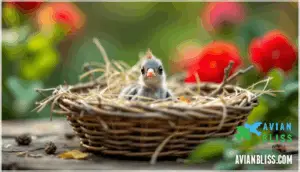This site is supported by our readers. We may earn a commission, at no cost to you, if you purchase through links.
 A female cardinal incubating her eggs doesn’t look like much is happening—until day 11 hits and tiny, alien-looking hatchlings emerge, weighing barely more than a penny. These helpless creatures, born completely blind with translucent pink skin, transform into confident fledglings in just three weeks.
A female cardinal incubating her eggs doesn’t look like much is happening—until day 11 hits and tiny, alien-looking hatchlings emerge, weighing barely more than a penny. These helpless creatures, born completely blind with translucent pink skin, transform into confident fledglings in just three weeks.
The speed of this metamorphosis rivals some of nature’s most dramatic changes, yet it happens in backyards everywhere, often unnoticed. Baby cardinals face a gauntlet of predators, weather extremes, and developmental hurdles from their first breath, making their survival a proof of both parental dedication and evolutionary resilience.
Understanding what these chicks need—and when human intervention helps versus harms—can mean the difference between life and death for these vulnerable songbirds.
Table Of Contents
- Key Takeaways
- What is a Baby Cardinal?
- Baby Cardinal Appearance
- Baby Cardinal Development Stages
- How Big Are Baby Cardinals?
- Identifying Baby Cardinals
- Baby Cardinal Diet and Nutrition
- Cardinal Nesting and Breeding Habits
- Parental Care of Baby Cardinals
- Common Challenges for Baby Cardinals
- Caring for Orphaned Baby Cardinals
- Frequently Asked Questions (FAQs)
- How do you identify a baby cardinal?
- How long do cardinal babies stay in the nest?
- What are baby cardinals called?
- What to do if you find a baby cardinal?
- How long do baby cardinals stay with their parents?
- Can baby cardinals survive cold temperatures?
- Do baby cardinals return to their birth nest?
- How do baby cardinals learn to sing?
- What predators pose the greatest threat to baby cardinals?
- When do baby cardinals learn to sing?
- Conclusion
Key Takeaways
- Baby cardinals transform from blind, 3.5-gram hatchlings with translucent skin into feathered fledglings in just 7 to 13 days, making their development one of the fastest growth spurts in backyard birds—they gain 2-3 grams daily and reach near-adult size within a month.
- Both cardinal parents share feeding duties around the clock, delivering protein-rich insects every 15-30 minutes and continuing parental support for up to two months after fledging, which is critical since most predation and injury risks occur during the vulnerable nestling and early fledgling stages.
- Orphaned or grounded baby cardinals should only be rescued if visibly injured, bleeding, or truly abandoned for over two hours—healthy fledglings hopping on the ground are normal and still under parental watch, and possessing them without proper permits violates the Migratory Bird Treaty Act with fines up to $15,000.
- Juvenile cardinals look completely different from their bright red parents, sporting dull brown-gray plumage and dark beaks for their first few months, with males gradually showing faint reddish tints around 3-4 months while females retain warmer brown tones.
What is a Baby Cardinal?
You’ve likely spotted a cardinal’s vivid red plumage in your backyard, but baby cardinals look nothing like their striking parents.
Before those iconic red feathers appear, these youngsters go through several fascinating stages of development.
Let’s start with the basics of what makes a baby cardinal and the proper terms ornithologists use to describe them.
Scientific Name and Classification
If you’ve ever spotted a baby cardinal and wondered what you’re really looking at, it helps to know that these little fluff-balls belong to the species Cardinalis cardinalis—the Northern cardinal—part of the Cardinalidae family that also includes grosbeaks and buntings. Taxonomy studies place these cardinal birds firmly in the order Passeriformes, the songbirds, and genetic research has traced their evolutionary history back millions of years.
Understanding bird classification helps with species identification, especially when you’re watching a cardinal mom feed her chicks or observing cardinal breeding habits up close. It’s fascinating how cardinal bird behavior reflects their place in the avian family tree.
Terminology and Definitions
When you’re talking about baby cardinals, it’s worth knowing the proper terms birders and ornithologists use—because "baby" doesn’t really cut it once you understand the specific life stages these birds go through.
A freshly hatched cardinal is a nestling, blind and naked in the nest. Once those flight feathers develop and they hop out—still clumsy but mobile—they’re fledglings. After a few weeks of growth, when they sport that brownish juvenile plumage but aren’t quite adults, we call them juveniles.
Understanding this avian terminology sharpens your species identification skills and deepens your appreciation of cardinal bird behavior and baby bird development throughout their fascinating lifecycle.
Baby Cardinal Appearance
When baby cardinals first hatch, they look nothing like the striking red birds you’re used to seeing at your feeder. These tiny hatchlings go through dramatic changes in just a few short weeks, transforming from naked, helpless chicks into feathered juveniles.
Let’s look at what baby cardinals actually look like from the moment they hatch through their early development.
At Birth
A newborn cardinal looks nothing like the bright red backyard visitor you’d expect—in fact, it’s one of nature’s most vulnerable little beings. These tiny hatchlings arrive almost transparent, weighing just 3.5 grams—lighter than a sugar packet. Here’s what you’ll notice:
- Naked, near-transparent skin with sparse down
- Eyes sealed shut, completely blind
- A few centimeters long—barely the size of your thumb
- Helpless, unable to lift their oversized heads
- Entirely dependent on parents for warmth and food
Cardinal eggs crack open to reveal nestlings that are honestly a little startling—fragile, almost alien-looking, with barely any feathery protection against the world.
Growth and Development
Within just a day or two, those fragile, barely-there hatchlings kick into astonishing overdrive—cardinals don’t waste time growing up. Feather growth starts around day seven, with mainly brown-gray juvenile plumage emerging.
Baby cardinals gain two to three grams daily during that first week—talk about rapid maturity rates! Beak development and wing formation progress fast, too.
By day ten, they’re practically unrecognizable, sporting their characteristic crest and showing real avian development milestones.
Physical Characteristics
You’ll notice that young cardinals look nothing like the vivid red adults you’re used to seeing—they’re wrapped in soft, dusky brown plumage with just a hint of rust-colored accents.
Their eye opening happens around days three to five, revealing dark eyes beneath translucent eyelids. Beak development progresses quickly, shifting from pale pink to the characteristic orange-red hue.
Watch for crest formation emerging around ten days—that’s when baby cardinals start looking recognizably cardinal-like!
Baby Cardinal Development Stages
Watching a baby cardinal grow from egg to independent bird is like witnessing a miniature miracle unfold in your backyard.
Watching a baby cardinal grow from egg to independent bird is witnessing a miniature miracle unfold in your backyard
These little red birds-to-be pass through four distinct stages, each with its own timeline and milestones. Let’s walk through what happens at each phase of development.
Egg Stage
Before that first crack appears in the shell, cardinal eggs spend 11 to 13 days quietly incubating in the nest—a deceptively calm period that’s actually packed with drama beneath the surface. During this incubation period, you’ll find the female cardinal sitting tight on her clutch while embryo development unfolds inside each delicate shell.
Here’s what’s happening:
- Egg Formation: Females lay 2-3 gray-white to greenish eggs measuring roughly 2.5 x 1.8cm
- Fertilization Process: Breeding peaks in late March through early April
- Cardinal Nest: Built in shrubs or trees using woven twigs and grasses
- Incubation Period: Averages 11-13 days, slightly longer early in breeding season
- Hatching Timing: Synchronized emergence guarantees all chicks develop together
Both parents share nesting duties, though Mom does most of the sitting.
Nestling Stage
The moment that shell cracks open, a wobbly, pink scrap of life tumbles into a world it can’t yet see—welcome to the nestling stage, where survival depends entirely on Mom and Dad. Baby cardinals weigh just 3.5 grams at birth, naked and blind with see-through skin.
Feather growth kicks in around day seven as their mainly brown-gray juvenile plumage emerges. You’ll notice their beaks developing fast—they’re gaining 2-3 grams daily while both parents hustle nonstop with high-protein insects to fuel this explosive growth.
Fledgling Stage
Around day 7 to 13, those scraggly nestlings take their first clumsy leap from the nest—awkward, fluttery, and barely airborne—but they’re officially fledglings now. You’ll spot them hopping along branches with stubby tail feathers, still sporting that scruffy brown-gray plumage while their wings strengthen.
Both parents stick close, offering flight lessons and steady meals—insects mostly—as these baby cardinals master landing and short bursts of flight over the next few days.
Juvenile Stage
After a few weeks of being fed by their devoted parents, these young cardinals shed their baby neediness and step into independence. Still brown and crest-topped, they are finally capable of cracking seeds and finding food on their own. Beak development and wing formation are nearly complete, though plumage change to adult red (in males) won’t happen until their first molt.
These juvenile cardinals hang around familiar habitat for weeks, perfecting cardinal behavior while their feather growth continues quietly beneath that drab exterior.
How Big Are Baby Cardinals?
If you’ve ever spotted a baby cardinal, you probably wondered just how tiny those little birds actually are. The size difference between a newly hatched chick and a full-grown cardinal is pretty striking, and understanding their growth patterns helps you identify what stage of development you’re looking at.
Let’s break down the measurements and milestones so you know what to expect.
Size at Hatching
When baby cardinals first crack out of their eggs, they’re impossibly tiny—weighing in at just 3.5 grams, about the same as a penny and a paperclip combined. These hatchlings stretch just a few centimeters long, with near-transparent skin and barely any down covering their fragile bodies.
Here’s what you’ll notice about cardinal eggs and fresh nestlings:
- Hatchling weight: A mere 3.5 grams at birth
- Birth length: Only a few centimeters from beak to tail
- Initial growth: Nestlings gain 2-3 grams daily during their first week
That initial growth kicks in fast—these baby cardinals are built for rapid development.
Growth Rate and Milestones
From that tiny starting point, cardinal chicks pack on weight at an eye-popping pace—doubling their mass in just a couple of days and reaching nearly adult size within a month.
By day 10, you’ll see dramatic changes: feather growth accelerates, their eyes open fully, and wing formation takes shape. Around two weeks, beak development becomes more pronounced and that signature cardinal crest starts emerging—a thrilling benchmark in baby cardinal development that signals they’re almost ready to fledge.
Adult Size Comparison
Once those two-week fledglings leave the nest, they’re surprisingly close to their parents in overall size—usually hitting around 25 grams (about 0.9 ounces) by the one-month mark, which puts them just shy of a full-grown cardinal’s weight.
Here’s how juvenile cardinals stack up against adults:
- Body Mass: Baby cardinals reach 85-90% of adult weight within 30 days
- Wing Span: Juveniles develop full 10-12 inch wingspan matching Northern Cardinal adults
- Beak Size: Nearly identical proportions emerge by fledgling stage
- Feather Length: Tail feathers remain slightly shorter until complete molt
- Growth Patterns: Final maturation continues subtly over several months
That rapid baby cardinal development means you’ll spot size differences mainly in behavior rather than measurements.
Identifying Baby Cardinals
Spotting a baby cardinal in your backyard isn’t always as straightforward as you’d think, especially when those signature red feathers haven’t come in yet. Juvenile cardinals look quite different from their vibrant parents, and telling males from females at this stage takes a careful eye.
Let’s break down what to look for when you’re trying to identify these young birds.
Differences From Adult Cardinals
If you’ve ever spotted a young cardinal hopping around your backyard, you might’ve done a double-take — these juveniles look surprisingly different from their vivid red parents. Unlike adult males with their striking scarlet feathers, baby cardinals sport dull brown-gray plumage that helps them stay camouflaged.
Their beaks start out dark gray rather than the iconic orange-red, and they’re noticeably smaller until reaching maturity around one month post-hatching.
Juvenile Plumage and Colors
Juvenile cardinals go through a fascinating color transformation that’s easy to track if you know what to look for. Here’s what makes their plumage development so distinctive:
- Brown-gray base feathers emerge around day 7, covering their naked skin with dull, mottled tones
- Buff-colored wing bars and streaky breast markings help with camouflage during the vulnerable fledgling stage
- Gradual molting process begins around 2-3 months, slowly replacing juvenile feathers with adult plumage
- Crest development starts appearing between 10 days to 2 weeks, signaling maturity ahead
Male Vs. Female Juveniles
Telling young male and female cardinals apart isn’t as straightforward as you’d think—they both sport the same drab brown-gray plumage for their first few months. The real giveaway comes during feather development around 3-4 months, when juvenile males start showing faint reddish tints on their wings and crests, while females retain warmer brown tones.
You might also notice subtle gender roles in cardinal bird behavior—young males often practice their territorial songs earlier than their sisters.
Baby Cardinal Diet and Nutrition
You might wonder what keeps those tiny, fast-growing cardinal chicks alive and thriving in the nest. Parent cardinals work tirelessly to deliver the right mix of protein and nutrients their babies need to develop properly.
Let’s break down what’s on the menu, why it matters, and how these chicks stay hydrated.
What Parents Feed Chicks
Cardinal parents are nature’s master chefs, carefully selecting a protein-packed menu that changes as their chicks grow stronger. During the nestling stage, they deliver a steady stream of soft-bodied insects—caterpillars, beetles, and grasshoppers—right to those gaping beaks. As fledgling care continues, parents gradually introduce seeds and berries, teaching their young what a cardinal feeder offers.
What’s on the menu:
- Protein-rich insects fuel rapid growth during those critical first days
- Soft caterpillars are easier for tiny beaks to swallow and digest
- Gradual seed introduction equips baby cardinals for independent feeding
Nutritional Needs for Growth
Growth demands a strategic balance of nutrients, and you’ll notice baby birds thrive when their bird diet hits specific targets. Protein requirements dominate—parents deliver 2–3 grams of insects daily, fueling feather growth and muscle development. Caloric intake jumps 60% in week one, reaching 40–50 kilocalories during peak growth.
Feeding schedules matter: every 30–45 minutes early on. Vitamin supplements become essential later—calcium, vitamin D, and vitamin A prevent nutrient deficiencies that cause skeletal issues and weak plumage.
Proper avian nutrition means feeding baby birds on time, every time. For ideal care, understanding wildlife nutrition needs is essential for their development.
Water and Hydration
You mightn’t think about water much when watching baby cardinals thrive in the nest, but hydration works differently than you’d expect for these tiny chicks. Parents deliver fluid balance through moisture-rich insects—caterpillars contain 85% water, meeting hydration needs without direct drinking.
Water intake happens naturally through diet, preventing dehydration risks that threaten bird health. Baby cardinals won’t sip from birdbaths until post-fledging, when cardinal bird behavior shifts toward independent avian care.
Cardinal Nesting and Breeding Habits
Understanding where cardinals nest and how they breed gives you insight into how those tiny hatchlings come to be. Female cardinals are picky about nest sites, and their breeding timeline shapes when you’ll spot baby birds in your yard.
Let’s look at the key pieces of their nesting puzzle.
Nest Locations and Materials
Female cardinals aren’t fussy architects—they’ll tuck their cup-shaped nests into dense shrubs, tangled vines, or the low branches of evergreens, usually somewhere between 3 and 10 feet off the ground where thick foliage offers cover from prying eyes. Your backyard becomes prime real estate when it offers the right mix of privacy and access.
Cardinal nest construction depends on what’s available:
- Tree species: Dogwoods, hawthorns, and dense conifers top the list for nest tree selection
- Material preferences: Twigs, grass stems, bark strips, and soft rootlets form the cardinal nest foundation
- Branch architecture: Forked branches or dense tangles provide natural support for bird nesting
- Nesting habits of Cardinals: Multiple nest sites scouted before final selection shows their cautious approach to cardinal nesting
Egg-Laying and Incubation
After choosing her nest site, the female gets down to business—laying one egg each morning until her clutch is complete, then settling in for nearly two weeks of round-the-clock incubation duty.
This brooding behavior spans 11 to 13 days, with cardinal eggs kept warm primarily by the female while the male brings her food. Incubation period timing varies slightly—eggs laid in March might take a touch longer than those in April.
Number of Eggs Per Clutch
Most clutches contain 2 to 3 eggs, though you might occasionally spot a nest with anywhere from 1 to 5—single-egg clutches are rare, but a family of five isn’t out of the question.
Here’s what influences clutch size variations in cardinal nesting habits:
- Female age and condition affect egg laying patterns
- Food availability during breeding cycles impacts production
- Territory quality influences nest success rates
- Seasonal timing alters fledging statistics
- Previous breeding experience shapes cardinal behavior and habitat choices
Parental Care of Baby Cardinals
Cardinal parents work together like a well-oiled team to raise their chicks from helpless hatchlings to independent birds. Both mother and father take on specific roles throughout the nesting period, from incubation through feeding and protection.
Let’s look at how these devoted parents care for their young through each stage of development.
Roles of Mother and Father
Both parent cardinals share nest duties in a surprisingly balanced partnership, though their specific tasks differ in fascinating ways. The female cardinals manage most incubation tasks, sitting on eggs while the male cardinals bring her food and stand guard.
Once chicks hatch, both parents dive into feeding responsibilities with equal intensity, making dozens of trips daily. The cardinal mom stays closer to the nest for brooding, while dad expands his territory defense—classic parental roles in cardinal bird behavior that optimize brood care success.
Feeding Methods
Watch a parent cardinal land on the nest’s edge, and you’ll see something extraordinary—they don’t just drop food into gaping mouths like you might expect. Cardinal feeding involves careful beak-to-beak transfer, where parents regurgitate partially digested insects directly into baby cardinals’ throats—a precise technique securing ideal nutrient requirements.
Baby bird feeding patterns include:
- Protein-rich insects dominate early food sources (caterpillars, beetles, grasshoppers)
- Feeding schedule intensifies to every 15-20 minutes during daylight
- Parents vary prey size as chicks grow
- Soft-bodied insects shift to harder-shelled varieties
- Both parents alternate trips, preventing exhaustion
This cardinal bird behavior maximizes growth without overwhelming digestive systems.
Duration of Parental Support
The relentless feeding schedule doesn’t end the moment those fuzzy fledglings tumble out of the nest—in fact, parental support stretches far longer than you’d think. Baby cardinals receive post-fledging assistance for up to two months after their nestling phase ends.
During this juvenile dependency period, parental care continues with frequent cardinal feeding sessions, teaching fledglings essential survival skills. This extended fledgling support showcases exceptional cardinal bird characteristics and parental care in birds.
Common Challenges for Baby Cardinals
Baby cardinals face serious threats from the moment they hatch until they can fly and fend for themselves. Survival isn’t guaranteed—predators, accidents, and environmental factors all take their toll during those vulnerable first weeks.
Let’s look at the three biggest challenges these young birds encounter.
Predation Risks
Predators circle cardinal nests like shoppers at a clearance sale—relentless, opportunistic, and always on the hunt. Nest predators threaten baby cardinals through various avian behavior patterns and predator avoidance challenges:
- Hawk attacks from above target fledglings learning to fly
- Snake threats raid low nests in shrubs
- Cat dangers from outdoor pets devastate ground-dwelling juveniles
- Raccoons and opossums destroy eggs and nestlings nocturnally
- Human impact through habitat destruction reduces protective cover
Wildlife conservation efforts emphasize understanding cardinal habits to protect vulnerable chicks.
Injuries and Illnesses
Vulnerability defines the early days of any baby cardinal’s life—injuries and illnesses strike fast and hard. Musculoskeletal issues like constricted toe syndrome affect over 10% of hand-reared chicks, while infectious diseases from unsanitary conditions threaten survival. Nutritional deficiencies cause developmental delays, and physical trauma from falls or pet attacks accounts for 5–15% of rehabilitator admissions. Environmental hazards like chilling increase mortality in fledglings.
If you’re caring for baby birds, contact bird rehabilitation centers immediately—veterinary care for birds and emergency bird care require expertise, and avian health advice from professionals dramatically improves outcomes. It’s essential to understand wildlife rehab procedures to guarantee the best care for baby cardinals.
| Health Challenge | Common Causes | Signs You’ll Notice |
|---|---|---|
| Musculoskeletal Issues | Improper substrate, vitamin deficiency | Curled toes, splayleg, inability to stand |
| Infectious Diseases | Contaminated tools, stress, antibiotics | White oral plaques, crop stasis, lethargy |
| Nutritional Deficiencies | Unbalanced diet, inadequate protein | Stunted growth, delayed feathering, weakness |
| Physical Trauma | Falls, pet attacks, nest accidents | Fractures, soft tissue injuries, bleeding |
| Environmental Hazards | Cold exposure, wet weather, toxins | Hypothermia, respiratory distress, weakness |
Abandonment and Orphaning
Sometimes, despite every watchful effort by devoted parents, a baby cardinal ends up alone—whether through nest disturbance, predator attack, or sheer misfortune. Abandonment signs include prolonged silence from chicks and empty nests after storms. Nest failure from predation or weather leaves orphans needing immediate fledgling support.
Here’s what causes orphaning:
- Predator attacks forcing parents to flee permanently
- Human disturbance triggering parental neglect of the nest
- Severe weather destroying nest structures completely
- Parent death from window strikes or predation
Contact bird rehabilitation centers for orphan care—emergency bird care and veterinary care for birds save lives when caring for baby birds demands avian health advice.
Caring for Orphaned Baby Cardinals
Finding a baby cardinal on the ground can feel overwhelming, but knowing what to do makes all the difference. The steps you take in those first moments can determine whether the bird survives or not.
Here’s what you need to know about helping orphaned cardinal chicks while staying within legal boundaries.
Immediate Steps to Take
Finding a tiny cardinal chick on the ground can send your heart racing—but staying calm and acting fast makes all the difference. First, check if the baby cardinal is injured or truly orphaned by observing from a distance for about an hour.
If the parents don’t return, gently place the bird nestling in a small box lined with soft tissues, keeping it warm and quiet. Contact your local wildlife rehabilitator immediately—they’re trained in emergency care and fledgling support, guaranteeing these fragile juvenile cardinals get proper help.
Proper Diet and Feeding
What you feed an orphaned baby cardinal isn’t just important—it’s literally life or death, since their tiny bodies need precise nutrition to survive and grow. High-protein puppy or kitten food mixed with baby cereal and supplements creates a proper bird diet that mimics their natural avian diet.
Here’s your bird nestling care strategy for baby bird feeding:
- Mix protein-rich formulas meeting nutrient requirements
- Follow strict feeding schedules every 15-30 minutes during daylight
- Add food supplements like calcium and vitamins
- Use hydration methods through moistened food (dietary restrictions: never plain water directly)
Legal and Ethical Considerations
Before rescuing a baby cardinal, understand this: Federal Protection under the Migratory Bird Treaty Act makes possessing them illegal without permits—violations carry fines up to $15,000 per bird. Wildlife laws require state-licensed rehabilitators to care for native species, ensuring animal welfare through ethical standards and proper training.
Here’s what Wildlife Rehabilitation Permits demand:
| Requirement | Federal Level | State Level |
|---|---|---|
| Authorization | U.S. Fish & Wildlife Service permit | State wildlife rehabilitation license |
| Facility Standards | NWRA/IWRC protocols, veterinary access | Housing, sanitation, species-specific diets |
| Training | Humane care standards, ethical codes | Documented capture/management methods |
| Purpose | Conservation efforts, animal rehabilitation | Wildlife rescue, wildlife conservation |
These animal rehabilitation regulations protect both birds and their wild futures.
When to Contact a Rehabilitator
Knowing the rules doesn’t mean you’ll always recognize when a baby cardinal actually needs rescuing—here’s when professional help becomes non-negotiable. Contact a wildlife rescue or rehabilitation center immediately if you spot visible injuries, bleeding, or labored breathing.
Orphan care requires emergency response when nestlings appear cold, dehydrated, or unattended for over two hours. Animal rehabilitation experts provide proper veterinary care and nutrition essential for bird survival—your injury assessment determines whether that call saves a life.
Frequently Asked Questions (FAQs)
How do you identify a baby cardinal?
Look closely at the beak—it’s your first clue. Baby cardinals sport stubby, dark bills that look almost charcoal-colored, completely different from the bright orange beaks of adults.
Plumage patterns emerge gradually, with juvenile cardinals showing muted brown-gray feathers instead of crimson. Wing development and feather growth reveal their age quite clearly.
How long do cardinal babies stay in the nest?
Cardinal chicks spend just 7 to 13 days in the nest before fledging, though they’re not fully independent yet.
Your backyard visitors leave their cozy nursery surprisingly early, but both parents continue feeding these fledglings for up to two months after nest departure.
What are baby cardinals called?
Like finding treasure in your backyard, discovering these young birds comes with special names. Baby cardinals are called hatchlings when newly emerged from cardinal eggs, then become nestlings while nest-bound, and finally fledglings after leaving the nest but still receiving parental care.
What to do if you find a baby cardinal?
If you spot a fallen chick, first determine if it’s injured. Healthy fledglings hopping near their nest don’t need rescuing—parents are likely nearby.
For injured hatchlings, contact a licensed rehabilitation center immediately, as Wildlife Laws require permits for proper emergency care and bird management.
How long do baby cardinals stay with their parents?
Fledgling cardinals leave the nest after 7 to 13 days but depend on mom and dad for food for up to two months—sometimes even longer.
You’ll notice family dynamics as juveniles stick close, learning survival skills before striking out solo.
Can baby cardinals survive cold temperatures?
Imagine nestlings huddled like bare-skinned balloons in a winter nest—they wouldn’t last an hour. Baby cardinals face severe hypothermia risk without complete feather development and parental brooding.
That’s why cardinal parents time breeding for warmer months, guaranteeing temperature regulation and winter survival aren’t battles their vulnerable chicks must fight.
Do baby cardinals return to their birth nest?
Once your baby cardinal leaves its birth nest, it won’t return. Fledgling behavior and cardinal nesting habits show these young birds move forward, exploring new territory rather than revisiting their original nest site.
How do baby cardinals learn to sing?
Young cardinals master song through vocal learning and sonic mimicry, listening intently to their fathers’ melodies during parental care of fledglings.
This bird communication develops gradually as juveniles practice song imitation, refining melody development through repetition—a fascinating aspect of cardinal bird life cycle and bird behavior that shapes cardinal habits.
What predators pose the greatest threat to baby cardinals?
Hawks, snakes, and cats rank among the deadliest Bird Predators for Northern Cardinal nestlings. Nest Raiders like blue jays and crows steal eggs, while domestic Cat Threats kill countless fledglings annually, making Wildlife Conservation Efforts critical.
When do baby cardinals learn to sing?
Vocal Learning in juvenile cardinals begins around 20 to 30 days after hatching, when fledgling songs emerge as simple chirps.
Baby Cardinals practice calls alongside their parents, gradually refining their repertoire through imitation and experimentation during Bird Development phases coinciding with Plumage Development in Birds.
Conclusion
From egg to independence, raising a baby cardinal is like threading a needle in a hurricane—nature’s margin for error stays razor-thin throughout their three-week sprint to adulthood.
You’ve now seen what these fragile hatchlings need to survive: protein-rich insects delivered every few minutes, protection from hawks and snakes, and parents who don’t quit even when weather turns brutal.
If you find one grounded in your yard, resist the urge to intervene unless it’s clearly injured—most fledglings hopping around are exactly where they should be, with vigilant parents nearby.
- https://birdfact.com/articles/baby-cardinals
- https://animaldiversity.org/accounts/Cardinalis_cardinalis/
- https://nestboxlive.com/blog/what-do-cardinals-eat/
- https://www.birdsoutsidemywindow.org/2018/06/25/scenes-of-cardinal-family-life/
- https://vitalratesofnorthamericanlandbirds.org/pages/bird.php?id=NOCA














